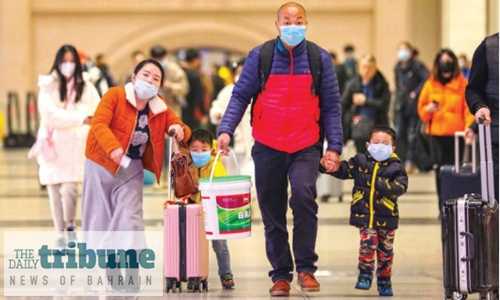Bahraini students in China urged to stay safe amidst Corona threat
In light of the current breakthrough of the deadly Coronavirus across China and its detection in several countries of the world, the Embassy of the Kingdom in Beijing has requested universities and educational institutions in China, where Bahraini students are enrolled, to extend the students’ holiday, sources confirmed.
Sources also told that the Embassy has requested these institutions to allow Bahraini students and trainees to return to Bahrain considering their safety. Additionally, Tribune learnt that the students there are on holiday until February 17, 2020, on the occasion of the New Chinese Year. Tribune obtained a copy of the circular sent yesterday by the Cultural Attaché Office of the Embassy of the Kingdom of Bahrain in Beijing to the Chinese universities and institutes, where Bahraini students are enrolled.
The circular mentioned: “Due to the recent event of Coronavirus breakout through the country, we kindly ask you to excuse our Bahraini students from either attending the universities classes or the internship programmes in the meantime and that until further notice from the Embassy of the Kingdom of Bahrain in Beijing. Your understanding in this matter is highly appreciated.” This came few hours after pleas were made online to facilitate the return of Bahraini students “stuck” in different parts of China.
Among the pleaders was MP Ammar Qambar, who said in a press statement: “The Bahraini Foreign Affairs Ministry should instruct the Ambassador of Bahrain in China to quickly communicate with the relevant health and security authorities in China to urgently return the Bahraini students from there, considering their health and safety.” He also said that the number of Bahraini students in China is estimated to be hundreds who are enrolled in different Chinese universities.
Mr Qambar affirmed that he will submit an urgent parliamentary proposal to demand the Government to adopt the swift return and evacuation of Bahraini students from China. According to the latest figures released by China’s National Health Commission, the never-before-seen virus, which was detected in the Chinese city of Wuhan, has claimed more than 56 lives and infected almost 2,000 Chinese citizens with a pneumonia-like illness.
The virus was first reported to the World Health Organisation on Dec 31 and has been under investigation since then. Chinese scientists have linked the disease to a family of viruses known as coronaviruses, the same family as the deadly SARS and MERS viruses. Scientists have yet to fully understand how destructive the new virus, known as 2019-nCoV, might be. Researchers and investigators are just beginning to understand where it originated, how it’s transmitted, how far it has spread and what its symptoms look like. As of Jan 22, case numbers have skyrocketed to over 440 in China and abroad.
Chinese authorities also confirmed health workers have been infected with the virus, suggesting that it has achieved human-to-human transmission. As a result, authorities are taking steps to guard against its spread. On Jan 22, the WHO will convene an emergency committee to explore whether the virus constitutes a public health emergency.
Researchers believe the number of cases may be higher than current reports suggest, and at least three US airports have begun screening incoming passengers for signs of illness, as have busy airports in Hong Kong, Singapore, South Korea and Malaysia. Coronaviruses belong to a family of viruses known as Coronaviridae and look like spiked rings under an electron microscope. They are so named because of these spikes, which form a halo around their viral envelope.
Coronaviruses contain a strand of RNA within their envelope and cannot reproduce without getting inside living cells and hijacking the machinery found within. The spikes on their viral envelope help them bind to cells, which gives them a way in. Typically, these types of viruses are found in animals ranging from livestock to household pets and wildlife such as bats. When they make the jump to humans, they can cause fever, respiratory illness and inflammation in the lungs.
In immunocompromised individuals, such as the elderly or those with HIV-AIDS, such viruses can cause severe respiratory illness. Extremely pathogenic coronaviruses were behind SARS (severe acute respiratory syndrome) and MERS (Middle East respiratory syndrome) and were easily transmitted from human to human.
SARS, which showed up in the early 2000s, infected more than 8,000 people and resulted in nearly 800 deaths. MERS, which appeared in the early 2010s, infected almost 2,500 people and led to more than 850 deaths.
Related Posts

